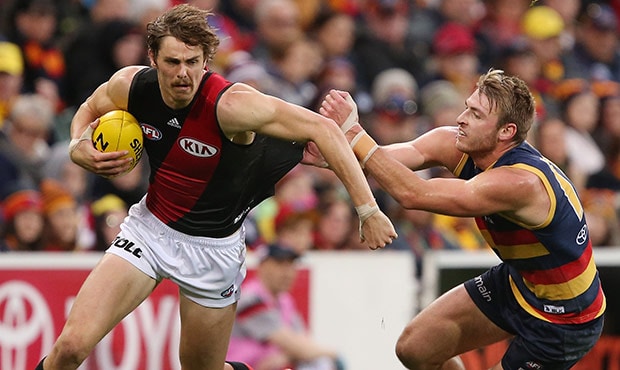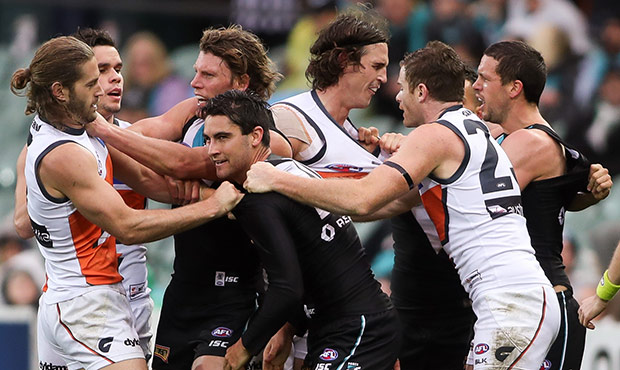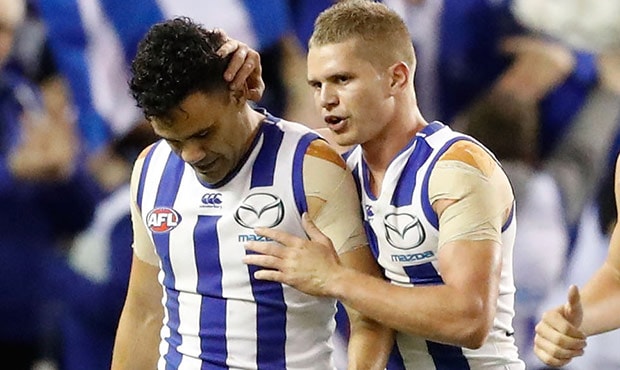
It was well documented that Sam Jacobs was slightly down on his best form in 2016, and that's reflected in the Crows having one of the worst hit-out differentials in the competition. What would be more alarming for Adelaide and its fans though is the team's ball use. When going by foot, the Crows were ranked 15th in the competition for efficiency, a stat that must improve in 2017 if the Crows are to go deep into the finals. - Michael Whiting

There were plenty of holes to pick with the Lions last season, and a couple really jump off the page. They're young, so can be forgiven for losing one-on-one contests, but the perceived lack of effort on occasions was borne out in the uncontested possession differential, where they ranked last. Opponents routinely transitioned the ball from one end of the ground to the other – think of heavy losses to Fremantle, Greater Western Sydney and Adelaide. New coach Chris Fagan has already stated defence is a priority in 2017, which will hopefully arrest this problem area. - Michael Whiting

The Blues' attacking woes have been an ongoing issue, underlined by the fact that former Crows half-forward Matthew Wright won the club's goalkicking this year booting just 22 majors. Without a dominant spearhead, Carlton struggled to convert inside 50s into scores, which has a knock-on effect in areas such as scoring differential from clearances. The Blues are still among the AFL's lowest tackling teams, although they laid nine more tackles a game last season compared to 2015 as first-year coach Brendon Bolton demanded a heavier focus on defensive mindset. – Travis King

Early last season, the Magpies came under intense scrutiny for their defensive frailties, as time after time they were exposed by opponents slicing through their team defensive structure. Collingwood tightened up as the season wore on, however Nathan Buckley's men need to prevent inside 50s against them becoming goals and stop rivals going coast-to-coast from kick-ins next season as part of their build back towards playing finals for the first time since 2013. – Travis King

With a makeshift team for 2016, it was little wonder the Bombers struggled in a number of areas, and it all amounted to plenty of pressure for the back six. Essendon didn't help itself, coughing up more than six goals a game in defensive half turnovers. Coupled with the fact it conceded almost 58 inside 50s a game, it's little surprise that only the Lions gave up more points. However, with a stronger midfield in 2017, some of these problem areas could be quickly turned around. - Michael Whiting
The Dons' forward fortunes rested almost solely on Joe Daniher last season. Picture: AFL Photos

The Dockers' revamped game-plan broke down last season, and it was the ease in which rival teams breached their normally watertight defence that was most startling. Freo's opponents converted inside 50s to scores from half of their entries – the third-most in the League – and the Dockers leaked 25 more points per game compared to 2015 when they finished on top of the ladder. Since the decline of Matthew Pavlich, the Dockers haven't had a dominant spearhead, which explains in part why Freo took the fewest marks inside 50 last season. However, the recruitment of Cam McCarthy and Shane Kersten, plus natural development of Matt Taberner, should see gains in that area. – Travis King

Despite averaging the third-most inside 50s last season, the Cats didn't always take full toll on the scoreboard and their lack of standout crumbing small forwards – and Steven Motlop's poor form - contributed to a poor forward 50m groundball differential. Somewhat surprisingly given dynamic duo Patrick Dangerfield and Joel Selwood's dominance around the contest, and Zac Smith's arrival, Geelong also struggled to convert getting first hands to the ball at stoppages into clearances. – Travis King

In Tom Lynch, the Suns have one of the best forwards in the competition – despite limited chances. Lynch kicked 66 goals in 2016, yet on average Gold Coast had the ball eight minutes less than its opponents in its front half. Imagine if Lynch had access to an even share of ball? The other worrying statistic for the Suns was their hit-out differential – ranked 17th – which they hope to rectify with the addition of former Magpie Jarrod Witts in the off-season. - Michael Whiting

The Giants had a brilliant season, but there are a couple of areas to improve on ahead of 2017. One of the most exciting teams in the league, which moves the ball freely and with waves of runners, the Giants were exposed when it came to one-on-one contests. They were ranked 16th for one-on-one offensive wins and 17th for one-on-one defensive losses. Discipline was also not a strong suit, with GWS conceding 54 more free kicks than they earned – second worst in the competition. - Michael Whiting
Ill discipline cost the Giants a plethora of free kicks in 2016. Picture: AFL Photos

With big man David Hale hanging up the boots, star forward Jarryd Roughead sidelined by his cancer battle and Ryan Schoenmakers missing for most of the season, the Hawks had to shake-up the way they moved the ball inside 50 last year. Without many tall marking options, Alastair Clarkson devised a plan for his trio of gun small forwards to terrorise defences at ground level, which is why the Hawks were determined to bring the ball to the deck and were poor at taking marks inside 50 and offensive one-on-one wins. Hawthorn was also dead last for contested possession differential, an area of the game Clarkson famously said he didn't "give a toss" about. – Travis King

The Demons made big strides last season despite some of their work in tight. Melbourne was ranked last for contested possession differential, conceding an average 20 a game to their opponent. This was also reflected in their offensive one-on-one wins, in which they were ranked 17th. With such a highly regarded midfield – where most of the contested work takes place – that includes Jack Viney, Nathan Jones and Bernie Vince, you could expect these numbers to improve in the coming season. - Michael Whiting

Kangaroos fans will still have nightmares about their round 13 loss to Hawthorn last season when they booted 11.18 to 14.9 in a bitter nine-point defeat. While that was an extreme case of inaccuracy, North was haunted at times by poor kicking late in the campaign. The Roos' tall timber in attack accounts for why so few marks in their forward half were uncontested, with North moving the ball long and direct to contests, although Brad Scott would like to see his men win more one-on-one battles in attack. Jarrad Waite and Mason Wood's returns from long-term injuries should improve that. – Travis King
Lindsay Thomas and the misfiring Roos have Jarrad Waite and Mason Wood to return. Picture: AFL Photos

Despite the acquisition of powerhouse Charlie Dixon, the Power struggled to take marks inside their forward 50, averaging just 10 a game. This might go hand-in-hand with the team's awful ball use by foot, where they were ranked last at just 62 per cent. With Paddy Ryder and Angus Monfries returning this season, there will at least be some extra targets to aim at – if the players up-field can kick it to them more accurately. - Michael Whiting

The Tigers struggled to score last season, ranked 15th with less than 80 points a game. While there was any number of reasons for that, their inability to transition the ball efficiently from one end of the ground to the other was telling. Richmond ranked 17th for moving the ball from its defensive 50 to inside 50, doing so just over one in every six times they attempted it. Once the ball made it to the forward half, the Tigers struggled to generate turnovers, intercepting the ball in the front half better than only two other teams. - Michael Whiting

Throughout St Kilda's gradual list build, a glaring weakness has been the key defensive posts. It's an area that Jake Carlisle and Nathan Brown should address next season, helping Alan Richardson's outfit win or at least break-even in more one-on-one contests down back. The Saints play a frantic and combative style under the Etihad Stadium roof, not dissimilar to the Western Bulldogs, which partly accounts for why they aren't further up the ladder for winning uncontested ball. – Travis King
Have the Saints finally found some backline cavalry to help Sean Dempster? Picture: AFL Photos

You wouldn't expect there to be too much wrong with the minor premier and runners-up, and that's exactly the case with the Swans. With almost half of their games played on the tight SCG, they love contested footy, so it's little surprise they're ranked 16th for uncontested marks. Perhaps the one slight concern for coach John Longmire as he chases a second flag in 2017, is that his men were a bit loose with the ball. The Swans were ranked 15th for disposals per turnover, giving the ball away almost one in every five times they had it. - Michael Whiting

With such a potent forward line – led by dual Coleman medallist Josh Kennedy – the Eagles become a force to be reckoned with given enough quality supply. At times last season, that didn't happen, notably an eight-point loss to eventual premiers the Western Bulldogs at Etihad Stadium in round 11 lost the uncontested ball count by a whopping 85 disposals. When the Eagles control the ball, they are a dangerous side and evening up that ledger would be a priority. It's an area where the exquisite skills of Sam Mitchell should help immeasurably. – Travis King

Hit-out differential and disposals per goal won't worry the Bulldogs too much, with Luke Beveridge's team clinching a fairytale premiership by swarming at ground level and sharing the ball in tight before getting out into space. The Dogs like to dominate around the contest and spread from there to score, which is why a low intercept-to-score percentage would also be of little concern to the reigning premiers. Ultimately, the one true indication of success is the scoreboard and right now the Bulldogs and their supporters are basking in the glow of the club's second flag. – Travis King



